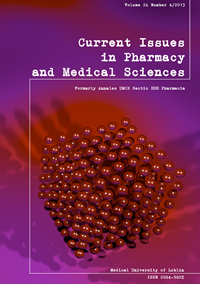Ultrastructural and morphohistochemical study of the influence of benzalkonium chloride on human corneal limbal epithelial cells
DOI:
https://doi.org/10.12923/j.2084-980X/26.4/a.25Keywords:
limbal stem cell, preservative, benzalkonium chloride, limbal insufficiencyAbstract
Within the corneal limbal epithelium there exist limbal stem cells (LSC) which under suitable conditions can regenerate their population or differentiate into corneal epithelial cells. However, upon limbal damage, the cells differentiate irreversibly and do not self-renew. One of the causes of the damage of progenitor cells and their niche is a long-term use of eye drops containing preservatives. While the side effects are related to the antimicrobial activity of such eye drops, damage to cellular and cytoplasmic membranes as well as enzymatic reactions can concurrently cause disorders of normal ocular surface tissue. The aim of this study was to evaluate the toxic effects of the preservative used in eye drops - benzalkonium chloride (BAK) - on human corneal limbal epithelial cells in vitro, and to define the mechanisms of acute limbal cell damage caused by the action of BAK. Ten corneoscleras rims, which were not qualified for transplantation by the Eye Tissue Bank, were obtained from 5 deceased donors aged 39 to 43 years. The tissue fragments (explants) containing corneal limbal epithelial cells were immediately after the explantation subjected to the action of the experimental substance being benzalkonium chloride (BAK) in concentrations of 0.005% and 0.01%. The qualitative analysis of microscopic images of the corneal limbus specimens was performed on tissue sections stained with hematoxylin and eosin using the immunohistochemical method for vimentin and with the use of a transmission electron microscope. The structure of the area of corneal limbus, as well as the morphological characteristics and the ultrastructure of the very limbal cells were evaluated with careful attention to the basal epithelial cells of the limbus. The BAK-treated groups of explants in sections stained by H & E featured characteristics of severe structural disorders of the corneal limbus area. Depletion of the epithelial cells was visible and involved both superficial and deep layers. Immunohistochemical staining for vimentin did not show the expression of this protein. This might have been connected with the damage to the cytoskeleton of limbal epithelial cells and large depletion of cells reaching down to the basement membrane. The images obtained with electron microscopy demonstrate serious defects of cell ultrastructure and, indirectly, abnormal cellular metabolism, including water and electrolyte balance and energy metabolism.This experiment confirmed the significant adverse effect of benzalkonium chloride on the limbal epithelial cells and the possibility of their damage.
Downloads
Published
Issue
Section
License
Copyright (c) 2025 Paweł Bieliński, Ewa Rakowska, Anna Wyszyńska, Monika Jasielska, Jerzy A. Walocha, Jerzy Mackiewicz (Autor)

This work is licensed under a Creative Commons Attribution-NonCommercial-NoDerivatives 3.0 Unported License.


